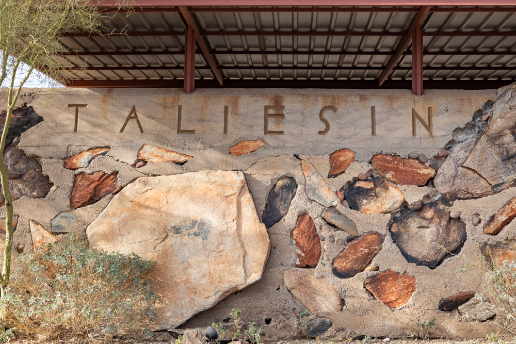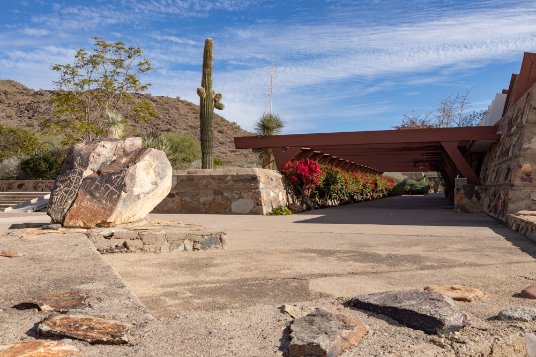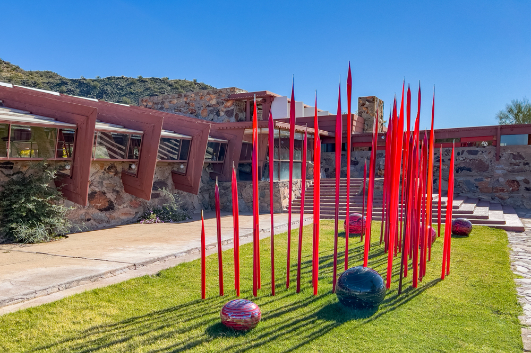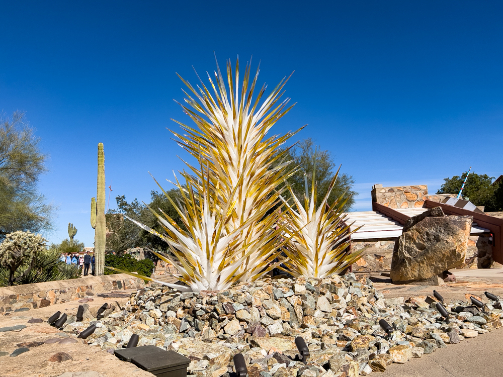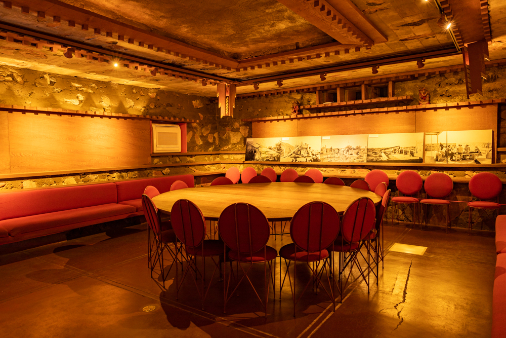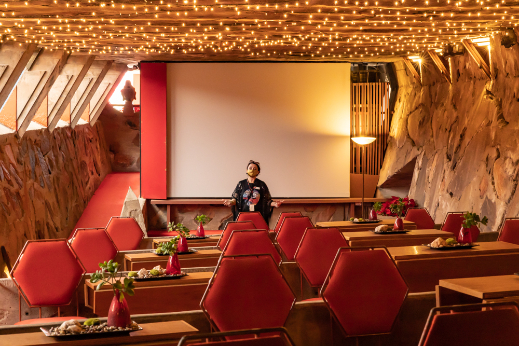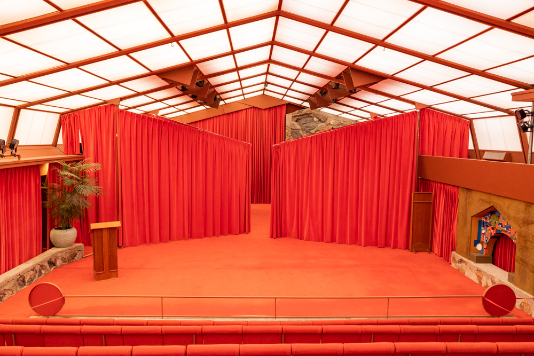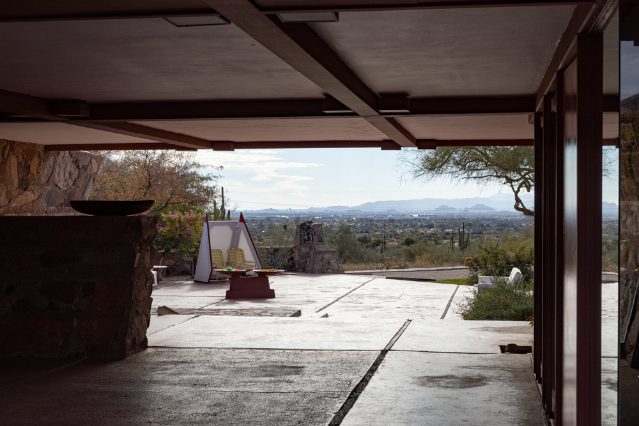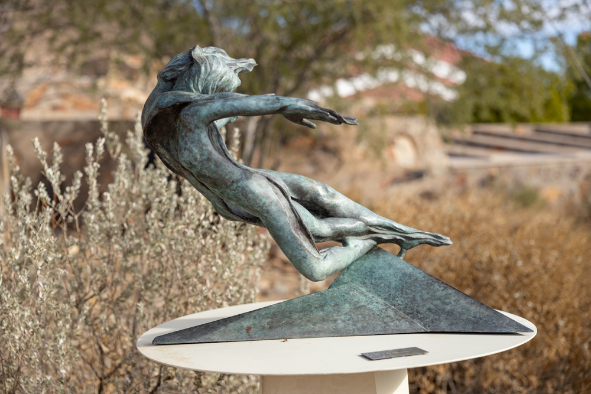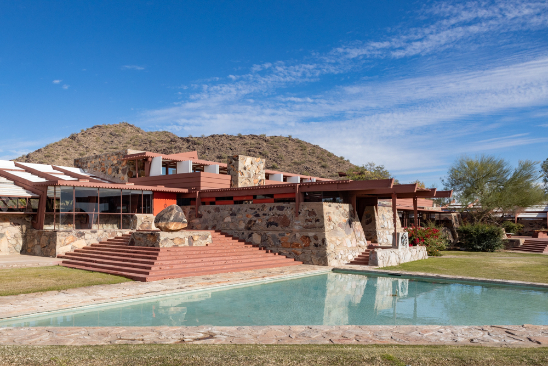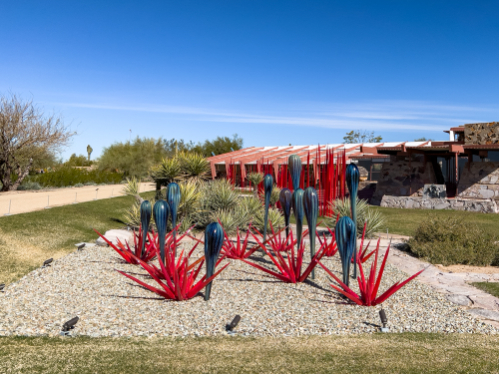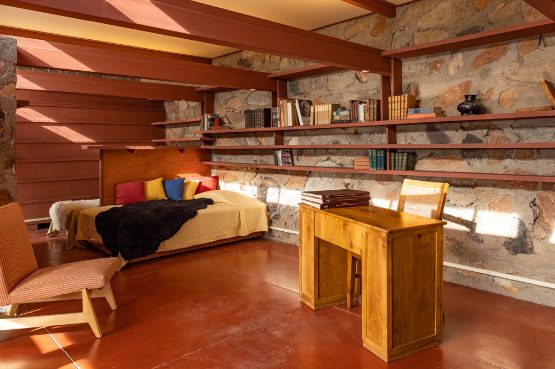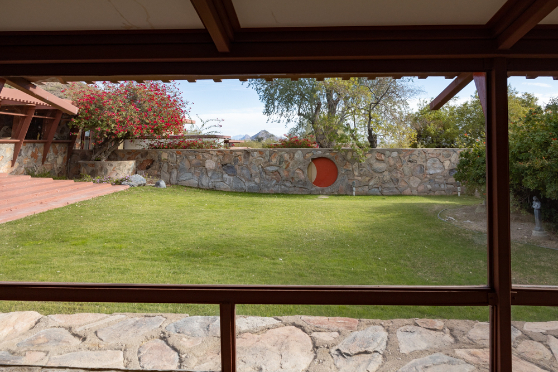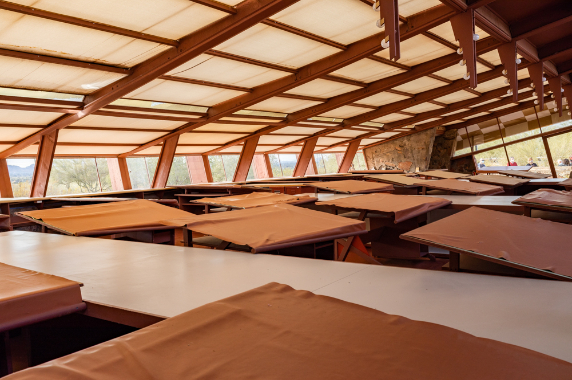What started as a simple tourist excursion in the Sonoran Desert in Arizona became much more for me. This four-part series begins with my introduction to Frank Lloyd Wright at Taliesin West in December 2020.
I’m getting to know Frank Lloyd Wright–the man and his life’s work–and his tremendous influence in architecture, art, and more.
From the moment you pull into the parking lot, the surrounding landscape is in the design of the parking structure. Rocks and boulders on the property fill the stonework walls throughout the buildings inside and outside.
The whirling arrow is the motif for Taliesin West found on a petroglyph that Wright brought to the property.
Frank Lloyd Wright wanted to bring the outside into the structures and blend with the surrounding landscape.
A Second Visit to Taliesin West
The graphic lines of Frank Lloyd Wright’s architecture and furniture captivate me. Therefore, a second visit to Taliesin West in February 2022 during the Chihuly exhibition taught me more about the depth and breadth of Wright’s artistry and vision. And, so, the quest began.
Dale Chihuly, a world-renowned glass artist, creates incredible and intricate works of art in blown glass. Using innovative techniques to achieve his artistic vision, Chihuly isn’t afraid of failure and loves experimenting. Frank Lloyd Wright wasn’t afraid to experiment and developed innovative methods to achieve his artistic and architectural vision. Chihuly’s art and their similar personalities fit perfectly together for Frank Lloyd Wright at Taliesin West.
Living Spaces at Taliesin West
The Garden Room, with the rocks and boulder masonry fireplace, was initially covered with canvas panels and replaced with acrylic. It is a natural extension of the garden and landscape and views Paradise Valley to the southwest.
Asian art featuring Cantonese theatre scenes marks the transition from one section of the property to another.
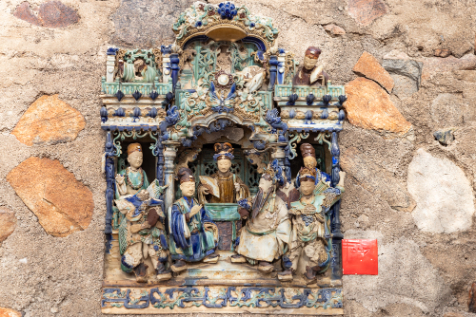
At Taliesin West, there are Asian influences throughout the property (Photo by ©Julie Diebolt Price)
Communal and Multi-Purpose Spaces
Frank Lloyd Wright was a well-rounded individual. He and Olgivanna enjoyed art and music and made it part of life at Taliesin. Apprentices and students participated in cultural performances of singing, acting, and dancing that the Wrights hosted.
Bringing the Outdoors In
Mountain and valley views emphasize openness and community. It was the distinctive Frank Lloyd Wright Prairie Style.
A Love of Sculpture
Some artists and Architectural Fellows, like Heloise Crista, continued to live with Frank Lloyd Wright at Taliesin West. Crista established herself as a sculptor, and many of her pieces have prominent space on the property.
Who Was Frank Lloyd Wright
Born in 1867, Wright was raised near Spring Green, Wisconsin. In 1878, the family settled in Madison, Wisconsin.
When he was 18 years old, Wright worked for the dean of the University of Wisconsin in engineering while studying there. He always knew he wanted to be an architect, and in 1887 he left for Chicago to work as an apprentice for renowned architects Adler and Sullivan.
Frank Lloyd Wright ‘s career spanned seventy years; he died in 1959 at almost 92.
Wright’s work from the first half of the 20th century strongly impacted architecture in America, Europe, and worldwide.
Wright designed 1,114 architectural works, and 532 were produced. He earned the title “greatest American architect of all time” from the American Institute of Architects. He proudly claimed that moniker.
Style of Architecture
The Frank Lloyd Wright buildings reflect the ‘organic architecture’ developed by Wright. This open-plan architecture blurs the boundaries between exterior and interior and uses steel and concrete, unprecedented in his time. Wright addressed solutions to work, worship, housing, education, and leisure needs.
In the Prairie Style, Wright established the first genuinely American architecture with a long, low, and open-plan structure that blended the landscape and the building.
The Usonian Style was affordable housing that offered simple but beautiful environments.
Frank Lloyd Wright was a short man, and his doorways were low. Low ceilings and compressed entrances give way to larger spaces in his designs. After you’ve been in a few of his buildings, you recognize this technique like an old friend.
In addition, entrances to his buildings are hidden and not revealed until you reach the front door.
Frank Lloyd Wright : The Man With a Self-Described Stormy Personal Life
At age 22, 1889, Wright married Catherine Lee Tobin. They grew a family with six children. He purchased property with borrowed money from Sullivan and experimented with the design.
Escalating expenses from Wright’s desire to have beautiful things caused him to take on independent residential commissions, which caused a breach-of-contract situation with Sullivan when he found out. It took 20 years to heal those wounds. That was the impetus, however, to compel Wright to work independently and develop homes that would belong on the American prairie.
In 1909, Wright left his family to spend an extended time in Europe with Mamah Borthwick (Cheney), a client he had loved for several years. During this time in Europe, Wright produced two publications, drawings, and photographs released in 1911. These publications established Wright internationally and greatly influenced other architects.
This same year, Wright and Mamah returned to Chicago. Spurned by their social circles, they built Taliesin near Spring Green, Wisconsin. He resumed his architectural practice and received public commissions for Midway Gardens in Chicago and the new Imperial Hotel in Tokyo, Japan.
In 1914, Mamah, her two children, and four others were killed at Taliesin by a domestic employee with a hatchet who also burned the house down in his rampage. This tragedy devastated Wright, who began to rebuild Taliesin in Mamah’s memory. After he completed it, Wright abandoned it for almost ten years while he pursued work in Tokyo on the Imperial Hotel.
After he returned from Japan, between 1922 and 1934, the years were creative architecturally but financially catastrophic for Wright. Commissions were scarce, and Wright abandoned his established Los Angeles office and returned to Taliesin.
A Steady Influence
In 1923, Catherine Tobin Wright granted Frank Lloyd Wright a divorce.
Olga Lazovich (known as Olgivanna) married Frank Lloyd Wright in 1928, providing a steadying influence in his life. He began writing and lecturing throughout the United States and inspired young architects. Wright and Olgivanna founded the “Taliesin Fellowship” apprentice program that integrated architecture, construction, farming, gardening, cooking, nature studies, music, dance, and art.
The brutal Wisconsin winters drove Wright and the Fellowship program to reside in the desert Southwest during the cold months in the 1930s. They migrated between Wisconsin and Arizona each year. The foothills of McDowell Mountain in Scottsdale, Arizona, became Taliesin West, the testing grounds for structural ideas, design innovations, and building details that mimic the dramatic desert landscape.
During World War II, Wright was commissioned to design a building to house the Solomon R. Guggenheim collection of artworks in New York City. It took 16 years to complete and is said to be his best work. He was overseeing the construction of the Guggenheim Museum at his death. I will cover this more in Part 4 of this series.
Frank Lloyd Wright – After Death
Frank Lloyd Wright’s remains were exhumed from the grave in Wisconsin and moved to Taliesin West after Olgivanna Lloyd Wright died in 1985 to fulfill her dying wishes. It launched a contentious dispute between the family and apprentices who knew Wright.
The School of Architecture at Taliesin, founded by Frank Lloyd Wright, and operated in Wisconsin and Arizona, closed its doors after 88 years in 2020.
UNESCO World Heritage List
Eight of Frank Lloyd Wright’s significant works are officially inscribed on the UNESCO World Heritage List.
They are:
- Unity Temple
- Frederick C. Robie House
- Taliesin
- Hollyhock House
- Fallingwater
- Herbert and Katherine Jacobs House
- Taliesin West
- Solomon R. Guggenheim Museum
It is also significant that these Frank Lloyd Wright buildings mark the first modern architecture designation in the United States on the World Heritage List.
I have visited five of the eight buildings in the United States, and I will share my discoveries in future articles with you here.
Frank Lloyd Wright in the Midwest
A trip to the Midwest in the fall of 2022 placed me in the Land of Frank Lloyd Wright in Chicago and Oak Park, Illinois, with Road Scholar. I found my “tribe” with this group. Their outstanding program, “Architectural Masterworks of Frank Lloyd Wright,” was educational, engaging, well-organized, and at a comfortable pace that encouraged learning. In the coming weeks, I’ll share more details about my Road Scholar experiences in Part 2 of this series.
Final Thoughts
The most significant discovery in this quest was about me. I’ve had Frank Lloyd Wright-style furniture in my home for 25+ years, and I didn’t even know it. We have several pieces of Prairie Style furniture, which I finally realized when I toured his buildings in Chicago.
See, you can teach an old dog new tricks!
For More:
- Frank Lloyd Wright.org
- Visit Arizona, https://www.visitarizona.com/
- On our site: Arizona’s Saguaro Lake: Water, Cactus and Mountain Views
- On our site: Arizona Getaways on a Shoestring Budget
- On our site: Straight Outa Old Town Scottsdale
-All photos courtesy of and copyrighted by Julie Diebolt Price. Cover photos depicts the Taliesin West Garden Room.


